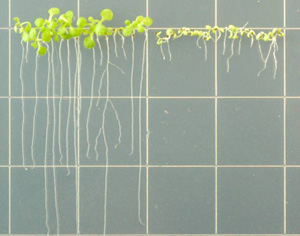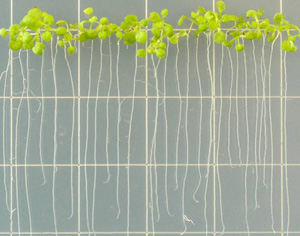Biologists Identify Genes That Control Toxic Metal Accumulation in Plants
November 17, 2010
By Kim McDonald

Knocking out the phytochelatin/heavy-metalloid transporter genes make the mutant plants (at right) sensitive to arsenic and unable to sequester arsenic in their vacuoles, which the plants with the genes at left are able to do.
Credit: David Mendoza-Cozatl, UCSD

Without the presence of arsenic or heavy metals, the mutant plants at right can grow robustly, like the wild-type plants at left.
Credit: David Mendoza-Cozatl, UCSD
Biologists at UC San Diego and four other institutions have identified a long-sought after family of genes that controls how yeast and plants accumulate toxic heavy metals and arsenic inside their cells.
Their discovery, published in two separate scientific papers, is a significant advance with the potential to restore environmentally damaged waste sites and protect the food supply from toxic metal contamination.
It could permit scientists to engineer plants capable of removing toxic metals from hazardous waste sites, a process called bioremediation. And it could allow them to improve crops to prevent or minimize their uptake of arsenic, cadmium and other toxic heavy metals in regions of the world where crops are grown in contaminated soil or irrigated with water containing toxic metals.
"Heavy metal and arsenic contamination has become a serious environmental problem that can cause cancer, dementia and other health problems in humans," said Julian Schroeder, a professor of biology at UCSD who led one of the research efforts, which identified a key gene in yeast that controls heavy metal tolerance and accumulation. "By targeting these genes, we may be able to keep heavy metals from accumulating in the edible parts of plants, such as rice grains, and fruits, as well as engineer non-food plants to better accumulate heavy metals in order to remove toxic metals from contaminated sites."
The discovery by Schroeder and his colleagues, which is detailed in a paper that is now available online and will appear in the December print issue of the Journal of Biological Chemistry, identified the long-sought gene in the genome of fission yeast, whose relatively small genome allows for rapid gene discovery.
The second paper, detailing the discovery of a similar family of genes in the plant Arabidopsis, is being published this week in the early online edition of the journal Proceedings of the National Academy of Sciences, by scientists at the University of Zurich in Switzerland, led by Enrico Martinoia and at POSTECH (Pohang University of Science and Technology) in Korea, led by Youngsook Lee, in collaboration with Schroeder and scientists in Schroeder's laboratory at UCSD.
Researchers at The Scripps Research Institute, Cornell University and the University of Zurich in Switzerland collaborated with the UCSD researchers on the study involving the discovery of the yeast gene, which turned out to be a close relative of the genes found in plants.
Heavy metals typically enter the human food chain via plants, which can concentrate these toxic substances from contaminated soil and water. Cadmium, lead, other toxic heavy metals and the metalloid arsenic are transported into plant cells and stored in structures called vacuoles, helped along by cell membrane transport proteins called "vacuolar heavy metal-phytochelatin transporters."
"These two papers report the discovery of the genes for these vacuolar heavy metal-phytochelatin transporters after a 25 year search by researchers around the globe," said Schroeder.
"Arsenic is one of the most serious threats to millions of people throughout the world," said Lee. "UNICEF estimates that 30 million people in Bangladesh and 6 million in India/West Bengal are exposed to drinking water contaminated by arsenic."
"People are also being poisoned by eating crop plants irrigated with arsenic-contaminated water, which causes many diseases including bladder cancer," said Martinoia.
"When toxic heavy metals or arsenic enter plant cells, they first bind to small molecules called phytochelatins," said Schroeder. "Then the heavy-metal-phytochelatin complexes are transported into the vacuolar organelles where they are stored. By storing heavy metals in vacuoles, plants are able to detoxify the heavy metals, by keeping the heavy metals away from other compartments in plant cells, where they would cause lethal reactions to the plants. However, when we eat plants for food, a large part of what we eat are these vacuole storage organelles."
Scientists have sought to identify the vacuolar heavy metal transporter genes from plants ever since the discovery published in the journal Science in 1985 of the small molecules, phytochelatins, which bind or attach to heavy metals in plants. Hoping to succeed where others failed, David Mendoza-Cozatl, a senior post doctoral scientist in Schroeder's UCSD laboratory set out to identify the heavy metal-phytochelatin transporter. He, Schroeder and their collaborators used a laboratory yeast strain, Schizosaccharomyces pombe, that had been shown to detoxify heavy metals in a similar way that plants do, by sequestering heavy-metal-phytochelatin complexes in its vacuoles.
"The yeast strain has a much smaller genome than plants and there are only 11 candidate transporters of the sort we were looking for in this yeast strain, whereas a plant genome typically contains 120 or more of these types of transporter genes," said Mendoza-Cozatl. "Finding the plant genes would be akin to finding a needle in a haystack, whereas in the yeast strain, the genome sequence told us that we might find the gene from among the 11 candidates."
By knocking out the candidate genes in the yeast strain, Mendoza-Cozatl, Schroeder and their collaborator Paul Russell at The Scripps Research Institute discovered that one of the genes and its encoded transporter are essential for cadmium tolerance in yeast and for cadmium-phytochelatin uptake into the vacuoles. The researchers further showed that transplanting the Abc2 transporter gene into a yeast strain that lacks this heavy metal detoxification mechanism enhanced cadmium tolerance and cadmium uptake in the second yeast strain.
"The ability to use the yeast transporter to bestow cadmium tolerance and accumulation to a different strain indicates that this gene may become useful for future engineering of non-crop plants for use in clean up of contaminated sites," said Mendoza-Cozatl.
The UCSD scientists said the discovery of the yeast gene could be used to engineer plants that can either store or divert heavy metals into non-edible plant tissues such as roots, rather than in edible plant tissues, such as grains or fruits, thus avoiding heavy metal consumption by humans.
In a separate investigation, the UCSD scientists, including Mendoza-Cozatl and Schroeder, collaborated with the researchers at the University of Zurich and POSTECH in Korea to identify two related heavy metal-phytochelatin transporters in the plant Arabidopsis thaliana. When both transporter genes were deleted from the plant genome, the scientists discovered the plants could not accumulate arsenic in their vacuoles.
"Future work may enable scientists to use the technology to avoid arsenic accumulation in rice grains, which exposes millions of people to arsenic, increasing incidence of cancer in large populations in India, Bangladesh and other countries," said Schroeder.
Additional collaborators included Oliver Limbo and Matthew Russell at The Scripps Research Institute, Olena Vatamaniuk and Zhiyang Zhai at Cornell University, Won-Yong Song at the University of Zurich, Jiyoung Park at POSTECH, and Timothy Jobe and Garo Akmakjian in Schroeder's laboratory at UCSD.
The research at UCSD was financed by grants to Schroeder from the UCSD Superfund Center grant from the National Institutes of Environmental Health Sciences and from the Chemical Sciences, Geosciences, and Biosciences Division of the Office of Basic Energy Sciences at the US Department of Energy.
Related Links- Julian Schroeder Lab
- Schizosaccharomyces pombe Abc2 transporter mediates phytochelatin accumulation in vacuoles and confers cadmium tolerance in Journal of Biological Chemistry
- Arsenic tolerance in Arabidopsis is mediated by two ABCC-type phytochelatin transporters in Proceedings of the National Academy of Sciences
